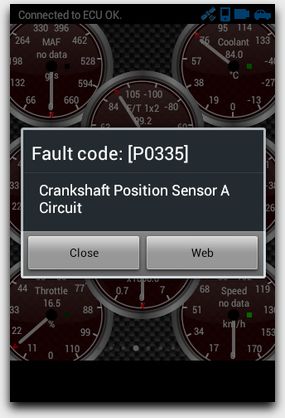When a Crankshaft sensor becomes defective in a combustion engine car, the engine can exhibit ‘jolts’ and, eventually, loss of power, when:
- Taking slip roads from dual carriageways or motorways.
- Navigating smaller roundabouts, usually when you’ve just slowed down, but not stopped.
- Driving through slower towns/villages after a faster run.
Sensor Fault Code
The logged Diagnostic Trouble Code (DTC) in my case was P0335. It’s a good idea to check if there are any other logged codes, in case there is a bigger problem:

DTC P0335
This code is common to many current combustion engine cars. I have had this issue with two so far; one was before I had any diagnostic tools. Depending on the vehicle, your car may be able to get the codes using the dashboard’s display if you know how.
Crankshaft Timing
Crankshaft timing is important –- it determines at what instant the spark plugs will fire. The ‘blip’ where the car jolts is because the sensor goes out of range, then the car’s ECU (Engine Control Unit) refuses to use the data. This means it won’t fire the spark plugs on that turn. You should get a warning light as soon as this occurs, and you should sort the problem out as soon as you can. If the sensor stays out of range long enough, you can lose engine power immediately, and that can be dangerous at the wrong time.
Reading Diagnostic Trouble Codes
With some cars, if you hold the accelerator and brake down, whilst turning the key to position 2, DTC (Diagnostic Trouble Codes) are listed one by one on the dashboard.
Some cars flash the codes using a sequence of lights; others display the codes on the dashboard (often without the ‘P’ prefix), and require you to push the trip meter’s button to advance to the next display.
Notes
If you do lose engine power due to a defective sensor, you will find it very hard to steer the car. You will likely also find you can’t restart it straight after this problem occurs. This is because the sensors tend to output out-of-range data when they’re hot. Simply switch off the car for about 10 minutes, and it will likely start again.
The Crankshaft sensor was easy to replace on my car and only cost about £11 to do myself. Resetting the fault codes was free, since I already had the equipment. This is in contrast to a garage, which can charge in excess of £100 for the part, fitting it, and then resetting the trouble codes. Many garages will charge a premium for resetting fault codes, and may do it whether you ask them to or not!
Replacing the Sensor
Replacing the Crankshaft sensor on my car involved these simple steps:
- Get the front of the car safely off the ground and secure it on axle stands.
- Locate the Crankshaft sensor, which should be directly underneath the engine.
- Unscrew one Torx screw.
- Remove the sensor, which is fitted in the bayonet style.
- Ensure the old rubber O-ring is still intact and wrapped round the sensor. This may be coloured red.
- Ensure a replacement O-ring is on the new sensor. This is important as it prevents water ingress, and you don’t always get one with the sensor. If you didn’t get one, you’ll need to buy one. If you’re very lucky, as I was, your local garage might give you a free replacement O-ring.
- Refit new sensor and retighten screw.
- Reset the engine fault codes.
